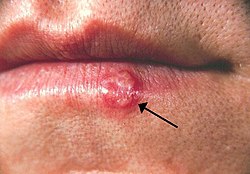| Herpesvirales | |
|---|---|
 | |
| Simplified diagram of Herpesvirales virion structure in cross-section. (1) nucleoprotein, (2) DNA, (3) capsid, (4) tegument, (5) envelope, (6) glycoprotein. Click to enlarge. | |
 | |
| Electron micrograph of various viruses from the Orthoherpesviridae family including Human alphaherpesvirus 3 (Chickenpox), Human alphaherpesvirus 1 , and Human alphaherpesvirus 2 | |
| Virus classification | |
| (unranked): | Virus |
| Realm: | Duplodnaviria |
| Kingdom: | Heunggongvirae |
| Phylum: | Peploviricota |
| Class: | Herviviricetes |
| Order: | Herpesvirales |
| Families | |
Herpesvirales is an order of dsDNA viruses (Baltimore group I) with animal hosts, characterised by a common morphology consisting of an icosahedral capsid enclosed in a glycoprotein-containing lipid envelope. Common infections in humans caused by members of this order include cold sores, genital herpes, chickenpox, shingles, and glandular fever. Herpesvirales is the sole order in the class Herviviricetes, which is the sole class in the phylum Peploviricota.

